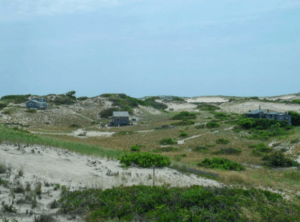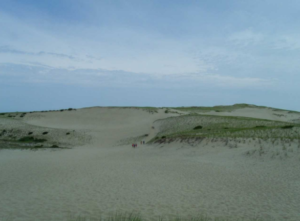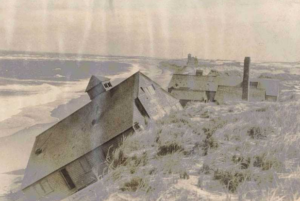
In the 21st century we are ruled by technology. There are few places left that hearken back to simpler times, making it difficult to unplug even if we wanted to. For those willing to put in the leg work though there is an area on Cape Cod that remains the same as it has for a hundred years. It is an area where when one gets there it feels as if you have been transported back several generations to a time before technology. It is the Peaked Hill Bars Historic District in the towns of Provincetown and Truro. It is home to some living history in the form of rustic dune shacks.
The Peaked Hill Bars Historic District encompasses 1,960-acres of shoreline in Provincetown and Truro. It was established in 2012 due to its significance to the artistic community during its heyday of 1920-1961. There are nineteen shacks of various sizes located among the dunes, eighteen of which are owned by the National Parks Service. Shacks sprung up in the second half of the 19th century though none of those originals remain. A lifesaving station would first bring attention to Peaked Hill Bars, however as time passed the isolation and serenity of the area would draw a much different crowd.
Peaked Hill was an area close to the present day Margo-Gelb dune shack in Provincetown, once the highest peak of the area it was gradually blown down by stiff winds. The ‘Bars’ refers to a pair of shifting sand bars which run parallel to the shore for six miles. These sand bars were the cause of many shipwrecks off the coast during the 19th century, giving the area the nickname ‘ocean graveyard.’ To try to combat the dangers offshore a lifesaving station was built high on the dunes overlooking the ocean in 1872. The shifting sands offshore have been matched by the shifting sands onshore as windswept dunes today reach as tall as 100-feet over the 1,960-acres.
Before the construction of the lifesaving station Peaked Hill Bars was nearly uninhabited by humans. Henry David Thoreau wrote of hiking this area in his 1865 book Cape Cod, finding it deserted but for a halfway house for shipwrecked sailors. Those who ventured out to the area after the station was built were there for the thrill of survival in a somewhat barren and hostile environment. An 1880 map of the area shows what appears to be the first shacks built in the area just northwest of the lifesaving station likely for fishing.
In 1914 the lifesaving station was decommissioned and was purchased for New York salon owner Mabel Dodge as a summer retreat. Its most famous resident would come in 1919 when playwright Eugene O’Neill moved in. While living amongst the dunes he wrote plays such
as Anna Christie, The Emperor Jones and The Hairy Ape. Though the station would be lost to the eroding cliffs in 1931 O’Neill’s residence at Peaked Hill Bars began a new chapter for the area.
After the turn of the 20th century more people began to visit the Peaked Hill Bars area for leisure. The availability of the automobile, subsequent completion of Rt. 6 in 1926, along with O’Neill’s residence in the area helped the population grow. Starting around 1920 more and more dune shacks would pop up. These would at times be populated by such famed creative minds as Jackson Pollock, E.E. Cummings, Harry Kemp, Norman Mailer, Tennessee Williams, and Jack Kerouac. At other times they would be used by residents of Provincetown who walked down Snail Road and across the dunes roughly a mile; a route that can still be used today.
Some of the dune shacks were repurposed sheds of the old lifesaving station, others were cobbled together with the help of driftwood washing ashore from shipwrecks. The artist colony of Peaked Hill Bars became the stuff of legend and a destination for established and up and coming artists looking for inspiration. In 1946 local Ford dealership employee Arthur Costa established a dune taxi service bringing people to and from the shacks. Art’s Dune Tours is still going strong more than seventy years later.
Ironically an act to save the landscape would spell the end of this renaissance of art on the Outer Cape. In 1961 the Cape Cod National Seashore was formed and the National Parks Service took ownership of the land on which many of the dune shacks stood. Several shacks which had been deserted over the previous years needed to be torn down while battles over ownership of the remaining shacks ensued. In 1967 most of the shacks owners settled with the government. The last case, that of the Fearing/Fuller/Bessay Shack dragged on until 1991, making it the longest lawsuit ever brought against the United States government. Only one, owned by the Malicoat family, remained private and still is to this day.
In 1989 most of the park-owned properties were deemed eligible for historic designation, despite the Seashore’s arguments against it. Since the mid-1990’s many of the shacks have been used as residence opportunities for artists, musicians, and writers. The shacks can be viewed if one wishes to take part in a dune tour. They also can be viewed if one wishes to take the longer route. There is a small parking area on Route 6, across from Snail Road, the same access path that has been used for decades. Though they are not always inhabited, when the shacks are it is important to remain a comfortable distance away, respecting people’s privacy.
A walk among the dunes is a rarity these days with the vast majority being protected from erosion. The opportunity to do something that was common in generations past should be taken advantage of. Getting the chance to view nature untouched, and the shacks where some inspirational work has been done, is simply the cherry on top of a fabulous Cape Cod adventure.
By Christopher Setterlund July 31, 2017 Capecod.com









